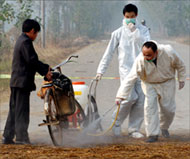New bird flu outbreaks in Asia
China, Japan and Vietnam have confirmed new bird flu outbreaks and warned of more likely infections.

The latest Chinese outbreak, discovered on 26 October, killed 8940 chickens and prompted officials to destroy 369,900 other birds in Badaohao, a village in Liaoning province, east of Beijing, the Agriculture Ministry said on Thursday.
China has reported three other bird flu outbreaks since 14 October. No human cases have been reported, but the authorities have warned that one is inevitable if the country fails to contain outbreaks in chickens and ducks.
The Japanese authorities said they had detected signs of bird flu at a farm in northern Japan and planned to kill 180,000 chickens.
A local daily newspaper said on Friday that the latest Japanese outbreak occurred at a farm in Ibaraki prefecture (state), 90km (56 miles) northeast of Tokyo, according to Yoshiko Otani of the prefectural livestock farming section.
Antibody tests on 80 chickens showed that all had been exposed to a bird flu virus from the H5 family but survived, the prefecture said in a statement. No active bird flu viruses were found, though. The chickens were kept in a free-range compound.
About 180,000 free-range chickens out of the 300,000 kept at the farm would be killed, Otani said.
More outbreaks feared
In Vietnam, more than 3000 poultry died or were culled this week in three villages in Bac Giang province, about 60km northeast of Hanoi, according to Nguyen Dang Khoa, the province’s vice-chairman.
 |
|
Vietnam has vaccinated poultry |
Vietnamese officials have banned the transport of poultry to or from the three affected villages, which have been disinfected, Khoa said. Settlements bordering the infected villages have also been disinfected and poultry have been vaccinated to prevent the virus from spreading further, he said.
However, Hoang Van Nam, deputy director of the Animal Health Department, said more bird flu cases were likely to occur.
“We expect more outbreaks, not just in Bac Giang, but also in other provinces,” he said. “Cooler weather now makes it easier for the virus to spread.” November to March is when Vietnam has reported most of its bird flu cases and deaths.
Vietnam began vaccinating its poultry flocks in early August, but its deadline of completing the vaccination of 150 million birds by mid-November may be delayed by at least two weeks because of a shortage of vaccines imported from China.
The deadly H5N1 strain of bird flu has killed at least 62 people, including 41 in Vietnam, according to World Health Organisation (WHO) figures, and resulted in the deaths of more than 100 million chickens in Asia since 2003.
Most human cases have been traced to direct contact with sick birds, but experts worry the virus could mutate and become easily transmissible between humans, possibly triggering a deadly flu pandemic.
Vaccine testing
Scientists in Vietnam have said they are ready to begin testing a new flu vaccine on human volunteers when they get government permission, following an $18 million allocation from Washington this week as part of US pandemic preparations.
Doan Thi Thuy, deputy director of the National Institute of Health and Epidemiology’s Vaccine and Biological Products No 1 Co, where the vaccine is being developed, said preliminary tests of the new vaccine on chickens and monkeys had produced promising results.
 |
|
The Asian Development Bank |
In a report released on Thursday, the Asian Development Bank has outlined a number of scenarios – some catastrophic – that could face Asian nations in the event of a global flu outbreak.
In a worst-case scenario, in which the psychological impact of a pandemic lasts a year, the bank said Asia could lose almost $282.7 billion or 6.5 of its gross domestic product in consumption, trade and investment and another $14.2 billion due to workers’ incapacity and death.
The report said growth in Asia would virtually stop, and the economic impact would likely force the world into a recession. That scenario assumes about 20% of Asia’s population would fall ill, and 0.5 % would die.
In a less pessimistic forecast, the bank said that if the psychological impact of an outbreak lasted for six months, the cost to Asia in lost consumption, trade and investment would be about $99 billion.
China, Hong Kong, Singapore, Malaysia and Thailand would likely be hit hardest by the pandemic, the bank predicted.
Compensation urged
A separate report by the World Bank said a human pandemic triggered by bird flu could cost the world economy as much as $800 billion.
“If other pandemics have taught us anything, it is that silence is deadly” Kofi Annan, |
Meanwhile, UN Secretary-General Kofi Annan urged governments to create better systems for compensating farmers with infected poultry stocks.
One way to control the disease’s spread is to slaughter sick flocks, but some countries do not have adequate procedures in place to compensate farmers whose livelihoods would be destroyed, Annan said.
“If they are not compensated, they are not going to tell you whether their birds are sick,” Annan said at a global health summit in New York. “If other pandemics have taught us anything, it is that silence is deadly.”